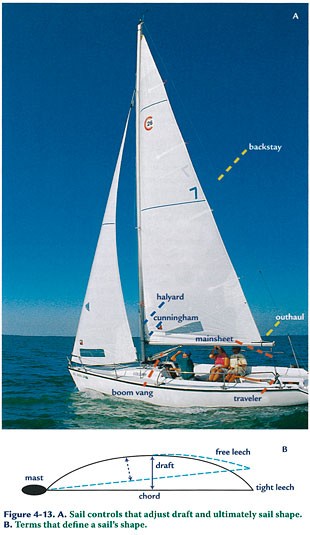As the velocity of the wind increases or decreases, you need to adjust the draft of your sails for the best efficiency. For instance, you set sail in a 10-knot wind and the shape of your sails looks good. Soon the wind increases to 20 knots and now you are overpowered. With older Dacron sails, the draft of your mainsail may have moved aft with stretch. The leech of the mainsail is tight and becomes a rudder in the air, steering you to windward. So, you need to flatten your sails and bring the draft of your mainsail back to its original position.
How to Flatten Your Sails
The outhaul stretches and flattens the lower part of the mainsail along the boom. The backstay bends the mast forward in the middle when tightened. This frees the leech, reduces weather helm, and makes a flatter sail. The cunningham tightens the lower luff of the sail, which keeps the draft forward. The halyard stretches the whole luff, particularly higher up.
Adjusting the Mainsail
 Mainsheet tension pulls the end of the boom down, tightens the leech, increases draft and increases weather helm. Be careful in light air about trimming the mainsail too tight. Remember: When in doubt, let it out.
Mainsheet tension pulls the end of the boom down, tightens the leech, increases draft and increases weather helm. Be careful in light air about trimming the mainsail too tight. Remember: When in doubt, let it out.
The traveler and boom vang also control tension along the leech of the sail. The traveler is a track that’s mounted behind the cockpit (sometimes behind the tiller, sometimes in front.) A sliding block with a part of the mainsheet reeved through it runs along the traveler and allows you to change the mainsail’s angle to the wind.
Tightening the Leech
The boom vang is an angled block and tackle arrangement or adjustable rod that runs from a tang or block on the boom to another fitting near the base of the mast or to a rail on the side of the boat. The boom vang keeps the boom from rising and keeps the leech tight.
A tight leech cocks to windward and causes a full sail because the chord line moves away from the belly of the sail, increasing the draft as shown as solid lines in the diagram (Figure 4-13B.) A loose leech falls off to leeward and flattens the sail (dotted lines.)
Reprinted from Fast Track to Sailing by Steve and Doris Colgate
Published by McGraw-Hill
Want to learn more? Check our our sailing tips and sailing courses.

